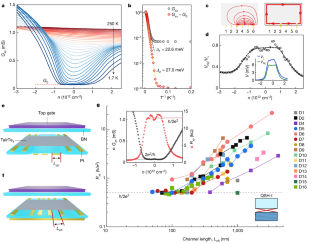Phys.org April 2, 2024
Introducing electron correlations to a quantum spin Hall (QSH) insulator can lead to the emergence of a fractional topological insulator and other exotic time-reversal-symmetric topological order, not possible in quantum Hall and Chern insulator systems. An international team of researchers (USA – Boston College, Harvard University, UCLA, Texas A&M, University of Tennessee, MIT, Singapore, Japan, China, Canada) has found a new dual QSH insulator within the intrinsic monolayer crystal of TaIrTe4, arising from the interplay of its single-particle topology and density-tuned electron correlations. At charge neutrality, monolayer TaIrTe4 demonstrated the QSH insulator, manifesting enhanced nonlocal transport and quantized helical edge conductance. After introducing electrons from charge neutrality, TaIrTe4 showed metallic behaviour in only a small range of charge densities but quickly went into a new insulating state. This insulating state could have come from a strong electronic instability near the van Hove singularities leading to a charge density wave (CDW). Within this correlated insulating gap, they observed a resurgence of the QSH state. The observation of helical edge conduction in a CDW gap could bridge spin physics and charge orders. According to the researchers their work provides a platform for exploring time-reversal-symmetric fractional phases and electromagnetism… read more. TECHNICAL ARTICLE

QSH edge conduction at the CNP in monolayer TaIrTe4. Credit: Nature, 20 March 2024